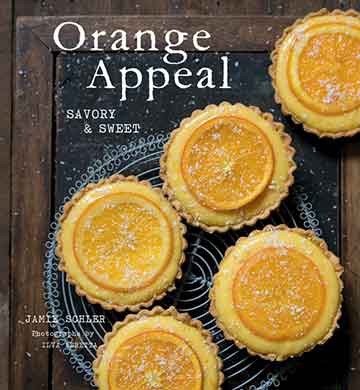
These impressive little desserts are an irresistible combination of sweet and tangy orange curd and candied orange peel nestled in a delicate coconut pastry. Kinda like a creamsicle on top of a cookie. It’s good—and, we dare say, necessary—that they’re made in individual tartlet pans because you’re not going to want to share yours with anyone.–Angie Zoobkoff
Want to Save This?

Orange Curd Tartlets
Ingredients
For the orange curd
- 6 large egg yolks
- 3/4 cup granulated white sugar
- 2 tablespoons cornstarch
- 1 heaping tablespoon finely grated orange zest
- 3/4 cup freshly squeezed orange juice (about 3 juice oranges)
- 1 stick unsalted butter, cubed
For the coconut pastry crust
- 1 1/4 cups plus 1 tablespoon all-purpose flour
- 1/2 teaspoon baking powder
- 1/8 teaspoon salt
- 1/3 cup dried coconut flakes
- 7 tablespoons unsalted butter, softened but cool
- 3 tablespoons granulated white sugar
- 1 large egg
- 1 teaspoon finely grated orange zest
For the candied orange slices
- 1 small orange, not more than 8 ounces (225 g)
- 3 tablespoons sugar
- 1 cup water
- 2 to 3 tablespoons flaked coconut, for serving (optional)
Instructions
Make the orange curd
- In a large heatproof bowl, whisk the egg yolks lightly.
- In a medium saucepan, stir together the sugar and cornstarch. Whisk in the zest and juice until the sugar and cornstarch are dissolved. Cook over medium heat, whisking vigorously, until thickened and just beginning to bubble, about 2 minutes.
- Slowly pour the hot orange mixture into the egg yolks in a thin stream while whisking vigorously in order to heat the yolks gradually and gently. Once the hot mixture has been whisked into the yolks, pour and scrape everything back into the saucepan. Cook over medium-low heat, whisking constantly, until it comes to a gentle boil, lowering heat if necessary so it doesn’t burn. Continue to cook and whisk until thickened, about 30 seconds.
- Remove the curd from the heat and whisk in the butter, 1 or 2 cubes at a time, until all the butter is incorporated and the curd is smooth and thick. If desired, strain the curd through a fine-mesh sieve, pressing with a spatula or the back of a spoon. Scrape the curd into a bowl or large measuring cup and cover with plastic wrap, pressing the wrap directly onto the surface of the curd to keep a skin from forming. Let cool to room temperature before refrigerating for several hours or, preferably, overnight.
Make the coconut pastry crust
- In a medium bowl, stir together 1 1/4 cups flour, baking powder, salt, and coconut. In a large bowl with an electric mixer, beat the butter and sugar until smooth and creamy, 2 to 3 minutes. Beat in the egg and zest.
- Beat the flour mixture into the butter mixture in 2 additions until completely mixed, about 1 minute. Turn the dough out onto a work surface floured with 1 tablespoon flour and gently knead just until the flour is absorbed and a smooth, soft but not sticky dough forms. Wrap in plastic wrap and refrigerate until firm, at least 20 minutes.
- Lightly butter 8 individual 3-by-1-inch (7 1/2 cm) round tartlet tins and place them on a rimmed baking sheet.
- Divide the dough into 8 equal portions and roll each portion into rounds more than 1/8-inch (1/4 cm) thick. Line the tartlet tins, carefully lifting the dough, pressing it into place, and pinching together any tears in the soft dough. Trim any excess dough above the edges. Refrigerate the tartlet shells while the oven preheats.
- Preheat the oven to 400°F (200°C).
- Line each shell with parchment or foil, fill with pastry weights or dried beans, and bake for 6 minutes. Carefully lift out the weights and parchment, and return the shells to the oven, uncovered, until golden brown, 8 to 12 minutes. Let cool completely on wire racks.
Make the candied orange slices
- You will be placing a single orange atop each tart so you want to make sure the orange you choose for candying is not wider than the inside of the pastry shell. Using a very sharp knife, cut the ends off of the orange, about 1/2 to 1 inch (1 to 2 cm). Cut the orange into 8 very thin, very ven slices, each about 1/8 inch (3 mm) thick.
- In a pan wide enough to hold all the orange slices in a single layer, combine the sugar and water. Bring to a gentle boil over medium heat and boil until the sugar has dissolved, about 2 minutes. Slide the orange slices into the liquid. Continue cooking at a simmer, carefully turning the slices every few minutes, until the orange pith and rind is soft and fairly translucent and there is only a thin layer of syrup remaining underneath the oranges, 11 to 13 minutes. Remove from the heat and let cool completely in the pan.
- When you are ready to assemble the curd tarts, carefully lift the slices from the pan and place them on a plate. Drizzle any remaining syrup in the pan over the orange slices.
Assemble the orange curd tartlets
- Gently pop the pastry shells out of the tins and place on a rack or serving platter. Remove the curd from the refrigerator and beat briefly to loosen and smooth. Divide evenly between the pastry shells and smooth the tops. Top each tartlet with 1 candied orange slice and dust with more coconut, if desired. Serve the orange curd tarts immediately or keep stored in the refrigerator until ready to serve.

Explore More with AI
Nutrition
Nutrition information is automatically calculated, so should only be used as an approximation.
Recipe Testers’ Reviews
This was a fun twist on classic lemon curd tartlets. The orange curd was delightful, almost tasting reminiscent of a creamsicle and the coconut was a nice addition. I really don’t think the tart dough needed that final step of kneading on the counter. I also only had enough curd for 7 of the 8 tarts using a 3 1/2-inch pan. Finally, all eaters said that the candied orange was pretty but too difficult to cut into; they all had to eat it in one fell swoop.
I always make and refrigerate citrus curd and make my tart shells the day before I need my tarts. This way the work is spread over two shifts which makes these DELICIOUS treasures seemingly labor free! Occasionally, no matter how much care is taken, you may be faced with a little bit of scrambled egg in the curd. To combat this, EVERY time that I make a curd, I always pour and push it through a fine strainer or sieve with a silicone spatula.
Next, I make the tart shells. Wrap the dough in plastic and refrigerate. At this point, you may either finish the shells (as I do) or complete them the following day before building your tarts.
I used 4-inch tartlet pans for this recipe which yields 4 orange curd tartlets. After dividing the dough, I roll it into 1/8-inch-thick rounds that are 1 to 1 1/4 inches larger than the diameter of the tart pans, allowing me to push the dough into the bottom corner of the pan and up and over the edge. With a bit of the dough draping over the tops of the pans you can lightly roll across the top with your rolling pin, which will cut the dough perfectly.
Put the tart pans on a sheet pan and refrigerate for at least 10 minutes. Preheat your oven. If you wish, you may dock the bottom of your pastries with a fork, I do it out of habit. Next, line the shells with foil and weight them with pie weights, dry beans or, as I do, sugar. Add your entire sheet pan, with the tart shells to the middle rack of the preheated oven and bake for six minutes. Take the pan from the oven, remove the foil and weights and return to the oven watching closely, bake until golden brown. This should take no more than 10 minutes. Remove the shells from the oven and allow them to cool completely on racks. I will normally cover and refrigerate until the following day. At this point your curd and tart shells will be completed.
I like to build my tarts a couple of hour before I need them. Next, you will make the candied orange slices. My initial thought was to slice the orange with my mandolin. DON’T DO IT! I found it difficult and dangerous. I recommend using a very sharp chef’s knife. The tart shells are AMAZING and can be used for nearly any tart you may conjure. The orange curd is DIVINE and the coconut is a splendid finale to a stunning tartlet. Some may speak of “leftover curd.” As a very honest fat man, let me assure you that there has never been, nor will there ever be such a thing as “leftover curd.” These same folks are likely to regale you with stories of wizards and unicorns…












This recipe is divine!
I enjoyed making it & with all the orange aroma, just a thrill.
Thanks, Maria. I’m so pleased that you enjoyed it. Thanks for taking the time to comment and rate the recipe.
Hillary, I’ve had a few people who are put off by the difficulty in cutting the candied orange slices. I really find that they add a marvelous and necessary tartness to the whole and don’t like to think that people would eschew them. But they do need initially to be sliced really as thin as possible. I also eat these tartlets with a knife and fork which may be why I never thought about them being too difficult to eat. I really am happy that you liked the tartlets!